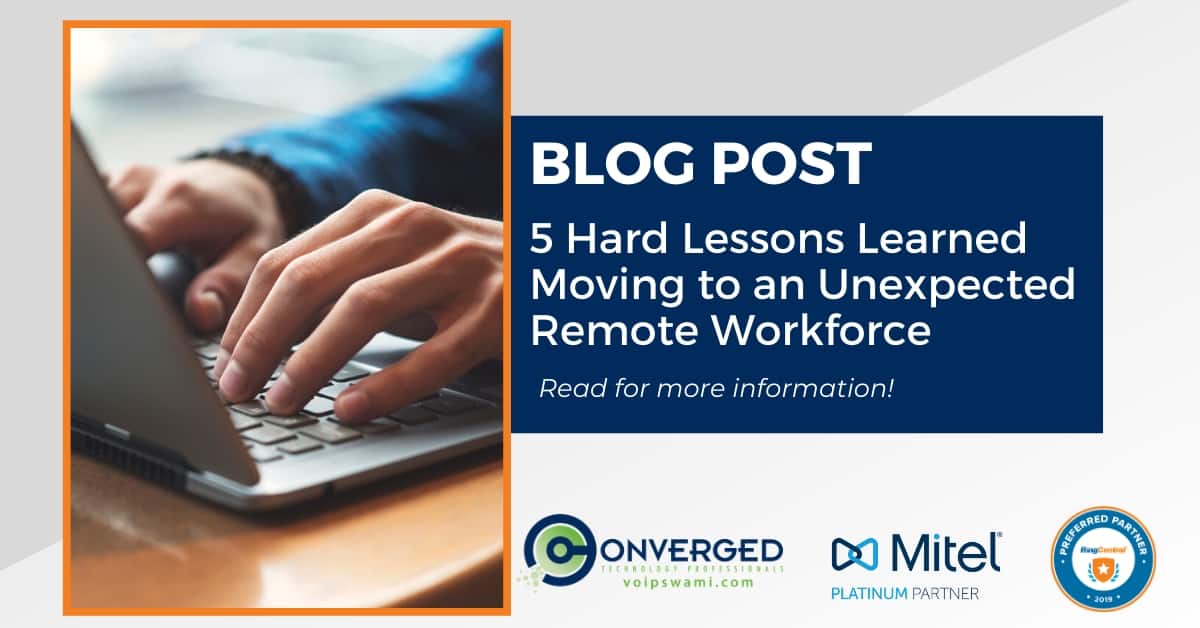
At the start of 2020, it was business as usual. No one saw the soon to be mandated, "stay at home" orders and lock downs. As a result, many companies were not only caught off guard but unprepared to cope or deal with the logistics of ensuring employees had the tools available to perform even the most mundane of tasks such as access email, answer and return calls, or hold online meetings.
We gathered five lessons from the global pandemic that will enable organizations to turn their previous challenges into opportunities. What lessons have we learned collectively and how can we avoid making the same mistakes in the event of a second wave?
The answers to these questions will help prevent the disruption, stress, and strain on your operations that impact not only your employees but also your clients.
#1 Not all employees thrive in a 100% remote or a 100% office environment
According to Gallop, employees that are fully remote are equally disengaged as employees that never work remote with only 30 percent of each groups being engaged. This statistic shows the importance of balance rather than determining what work style is best and why the new way of working needs to be more flexible.
Businesses should not be wasting time discussing remote working vs. office working. A more organic approach that paves the way for fluid working in the office or at home depends on the task at hand and requires an improved structure with the right tools in place. By focusing on employee wellbeing, technology can be an excellent enabler for staff to leverage the best of both worlds.
#2 Every department has different requirements and needs for remote work
Every department will have different reasons for wanting to work at home or in the office. If we have learned anything this year, it's to expect the unexpected. Should a stay at home order happen again, we need to remember that the resources that remote workers need can be different depending on the type of role the person has.
Many companies didn't have the right tools and processes in place at the time of the stay at home order. Some would also admit that they were winging it in a lot of areas. For many, the global pandemic thrust them into an environment where they had no structure.
As a RingCentral Premier Partner and a Mitel Platinum partner, we can tell you first-hand our customers that came to us asking for advice and strategic direction were able to get the proper guidance needed that other businesses without a partner weren’t able to benefit from.
We know our customers’ goals and infrastructure and are therefore able to provide qualified consultative input as we understand that every employee will have a different list of requirements that allow them to collaborate, focus, and socialize with their colleagues.
Many businesses still need to retire the notion of a one-size-fits-all approach to work from any location in a post-pandemic digital world.

#3 Video communications deliver more value than previously realized
Both users and businesses discovered that video communications are more valuable to them than they previously realized. Adding a human touch to conversations that cannot be achieved by phone calls or emails now plays a critical role in how we communicate.
It has also enabled many employees to find their groove working from home. Overnight, Zoom was transformed from a niche video conferencing tool to a core application for businesses and the global community. But it also highlighted how businesses were lacking ways to facilitate easy and secure communications.
When teams are scattered across multiple locations, teams need asynchronous communication to collaborate effectively. A unified communications partner can help your employees perform their roles with greater efficiency and productivity.
Communication tools are no longer limited to a physical office. Remote workers should be able to conveniently collaborate with their colleagues by leveraging the same tools as those inside the office, such as instant messaging, video, and audio conferencing. But advanced call transfers and routing options are also critical features to be considered when looking at a robust unified communications solution.
#4 Businesses were unprepared for remote working
Businesses and even the Pentagon were unprepared for remote working and dealing with a situation where offices were forced to close. But this shouldn't be just about Covid-19. Business continuity and disaster recovery should be in place to help a business deal with emergencies such as natural disasters, flooding, and any disruption in service.
Employees are also increasingly expected to work from home and meet deadlines if they do not feel well enough to commute to the office or want to avoid distractions. Providing the flexibility to work remotely will also play a significant role in how you secure the future talent for your company too.
Most organizations were unprepared to deal with the effects of the global pandemic. Many learned that they didn't have unified communications in place to bring their employees together during a crisis. Armed with the information that the second wave could happen, businesses must prepare to expect the unexpected.
#5 HR Policies Didn’t Cover Remote Work Scenarios
Many companies discovered that their HR policies didn't reflect business processes for when, how, who, and why employees should work from home. HR policies and traditional processes are currently being re-written to ensure their organization can be more agile and find the right balance in working practices.
With employees scattered, enabling them to securely access sensitive company data and core applications when working from home has also become crucial. If there are any positive lessons to learn from the Corona virus outbreak, it's that we are finally questioning the traditional ways of working and discovered that they existed mostly because of convention, rather than a necessity.
Ask yourself, what do you wish you could do over again and how can you better prepare to ensure you continue to adapt and thrive in a new era of uncertainty?
The lessons we have learned combined with leveraging communications technology will help your business avoid making the same mistakes again.
Now is the time to prepare for the future of your business.
If you enjoyed this article you may also enjoy:
